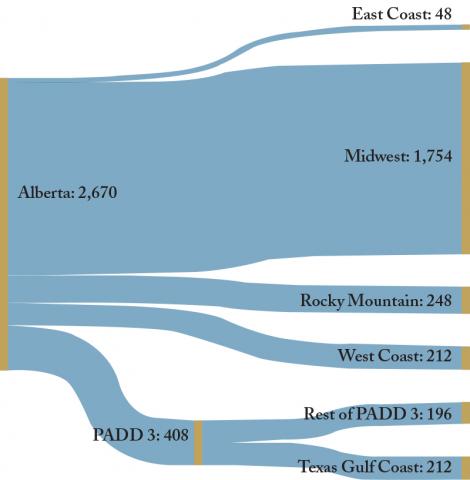From: Benjamin Dachis
To: Canadian Energy Producers
Date: September 4, 2017
Re: Hurricane Harvey Shows the Risk of Having Few Pipelines
Canadians were spectators as Hurricane Harvey ravaged south Texas, but the storm shows the long-term risk of being reliant on our oil exports going to a single country.
Alberta sent about 80 percent of all the oil it produced to the United States in 2016, according to the Alberta energy regulator. For oil to turn into gasoline, that oil needs to find its way to a refinery near lots of consumers or with a pipeline that ships the products to them.
Most of the oil that Alberta ships to the US ends up in refineries outside Hurricane Harvey’s path. The United States government assigns each state to a Petroleum Administration for Defence District (PADD). Most of Canada’s oil goes to PADD states in the Midwest unaffected by the hurricane, for now.
But the second largest destination of Alberta’s oil is PADD 3, which covers the Gulf Coast (see Figure). According to US Energy Information Agency data, about half of the total refining capacity of refineries in PADD 3 is along the Texas Gulf Coast. It is also the fastest growing destination for Canadian exports, and will only keep growing with the Keystone XL expansion.
Assuming that Canadian oil destined for PADD 3 has the same likelihood of going to Texas Gulf Coast refineries as oil elsewhere in the district, about 212,000 barrels per day of Alberta oil is not getting to its destination. Other projections are even higher. That’s the equivalent of shutting down almost 10 percent of the oil sands.
The impact on Alberta is minor, for now. However, if the shutdown of Texas Gulf Coast refineries is prolonged, Canadian oil producers may bear a much larger cost because of Canada’s limited pipeline network.
Texas Gulf Coast refineries represent about a quarter of the total US refining capacity. Oil producers who were previously sending their oil to refineries along the Texas Gulf Coast will soon start shipping their oil to other inland refineries. They can do that because the United States is a tightly integrated oil market with pipelines crisscrossing the nation. Producers from abroad who sent their oil by boat to Texas can send their oil elsewhere as well.
Canadian oil producers don’t have the same luxury. Their dependence on pipelines that serve the US Midwest means that they won’t have the ability to serve other markets once more US production competes for limited space in those refineries. The key measure to watch will be the spread between prices in Alberta and prices in the Midwest US. If Canadian energy producers aren’t cost competitive with their new competitors, the economic shockwaves from Hurricane Harvey will hit Alberta.
Exports of Alberta Oil to US, Thousands of Barrels Per Day, 2016
Source: National Energy Board
Ben Dachis is an Associate Director of Research at the C.D. Howe Institute.
To send a comment or leave feedback, email us at blog@cdhowe.org.






